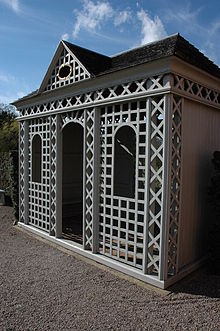Gazebo

A gazebo is a small, open building, usually made of wood or cast iron , that allows you to stay outdoors protected from the sun or rain. It was particularly widespread in the 19th and early 20th centuries, stylistically based on the kiosk that had become fashionable in the 18th century with the English landscape gardens . In contrast to the pergola , which is usually leaned against another structure as an extension, the arbor is always free.
With a symmetrical structure, a gazebo is also known as a pavilion . In colloquial language , the garden house is sometimes also called a gazebo. If it is mainly used to store garden tools and materials, it is more likely to be called a tool shed . Use of language and naming are sometimes fluent.
The journal Die Gartenlaube , which appeared from 1853 to 1944 and was founded by the liberal publisher Ernst Keil , was named after the gazebo.
Word meaning
The word arbor developed from the Middle High German loube = porch; Gear; Speicher, Old High German louba = protective roof, hut, originally = protective roof made of leaves. The further origin is unclear. According to folk etymology , arbor includes a place in the open air, which is surrounded by trellises made of wood or metal, overgrown with foliage- bearing plants and in this meaning denotes a niche (or place) protected by foliage and providing shade, which is suitable as a quiet seat .
Moving into the cities
The wealthy residents of the cities took up the recreational aspect of the gazebos created in this way. Because there was not enough green space in the street canyons, they built their garden sheds on the homesteads of the actual residential buildings. Mostly it was a scaled down copy of the main house, which - like its landscape gardening model - was designed as a short-term retreat.
Suggestion for future allotment gardens
The temporarily used building inspired the Leipzig doctor Moritz Schreber to create lawns that are used exclusively for recreation. But it was only his son-in-law Ernst Innocenz Hauschild and his colleague Heinrich Karl Gesell who finally put the plan into practice: They bought land at the gates of the city, divided the area into several parcels and leased them to the less affluent residents of the numerous tenements. The use of the resulting allotment gardens was tied to conditions such as the cultivation of fruit or vegetables or the maintenance of a green area. This should give city dwellers the opportunity to eat healthily and relax.
In 1983, the Federal Allotment Garden Act restricted the size of a gazebo to a maximum of 24 m² floor space including a covered patio. Furthermore, an arbor must not be suitable for permanent living.
Use as a tool shed
The equipment required for agricultural work was deposited in a specially built shed - which could also be used as a shelter in rainy weather or in great heat. The gazebo thus returned to its actual destination via a detour via the cities.
To this day, the houses are mainly used to store tools, garden tools or supplies from our own harvest. In many cases, however, they are also used to organize leisure time or as a holiday facility. In this context, however, there are considerable differences between a gazebo on your own property and a building in the allotment garden association.
See also
literature
- Gerlinde Volland: Swan song on the arbor . In: Die Gartenkunst 18 (2/2006), pp. 373–384.
- Hermann Hunter . The gazebo . In: The Gazebo . 1856. Issue 20, pp. 267-270.
Individual evidence
- ^ Dictionary German , accessed on October 27, 2017
